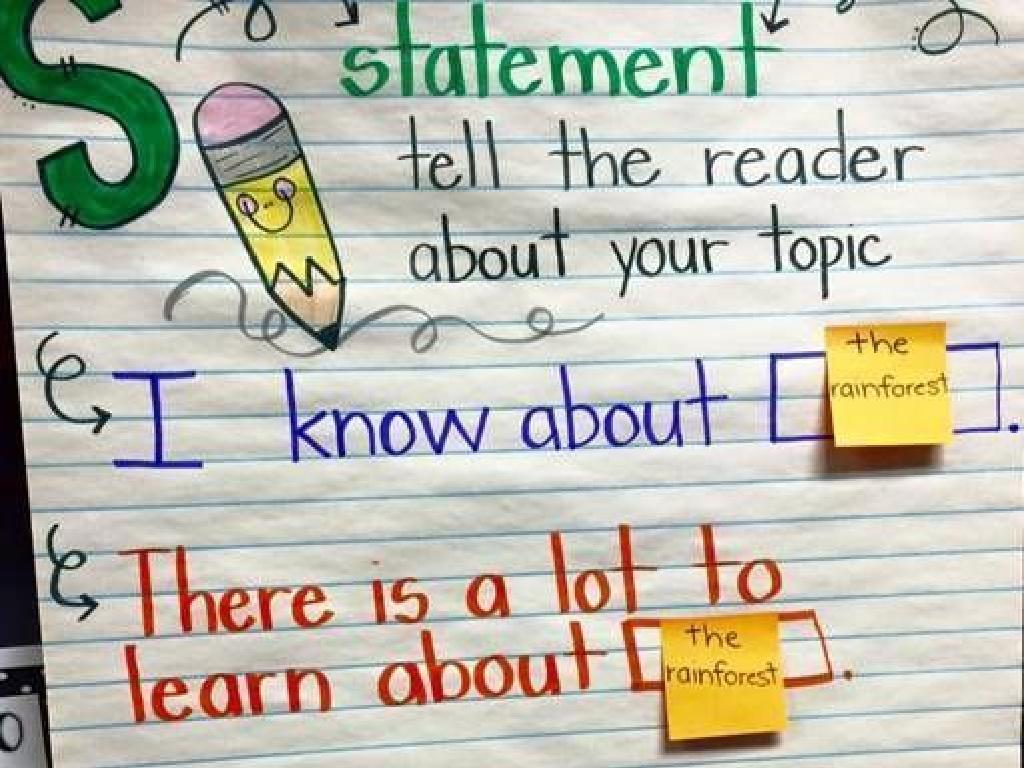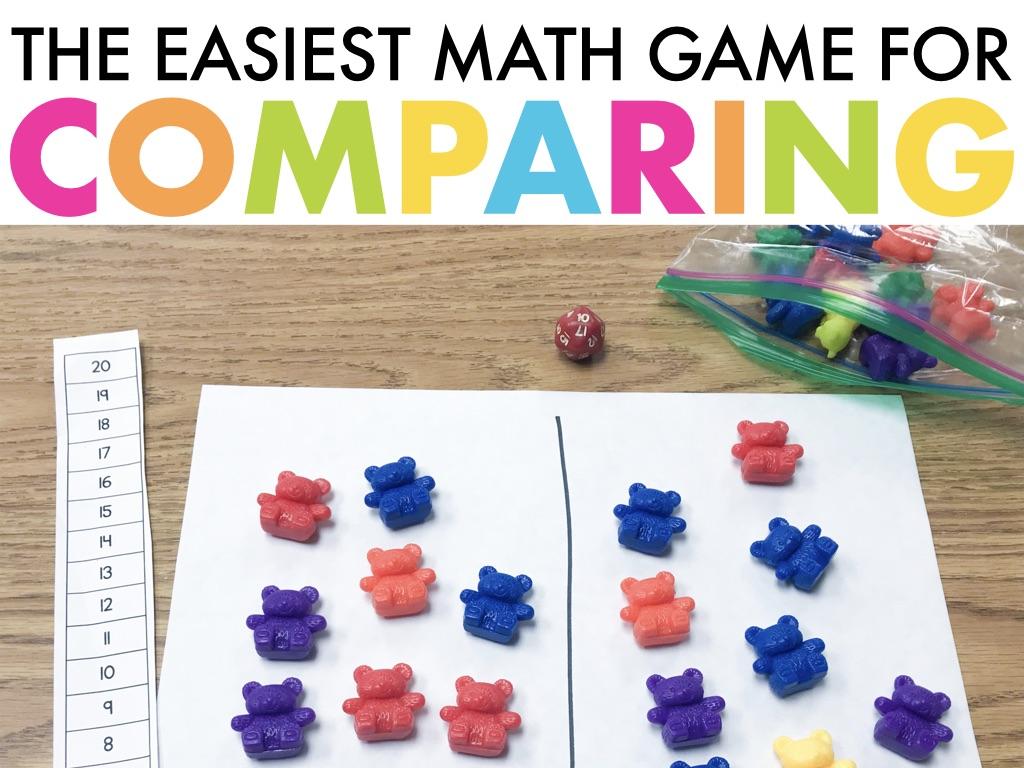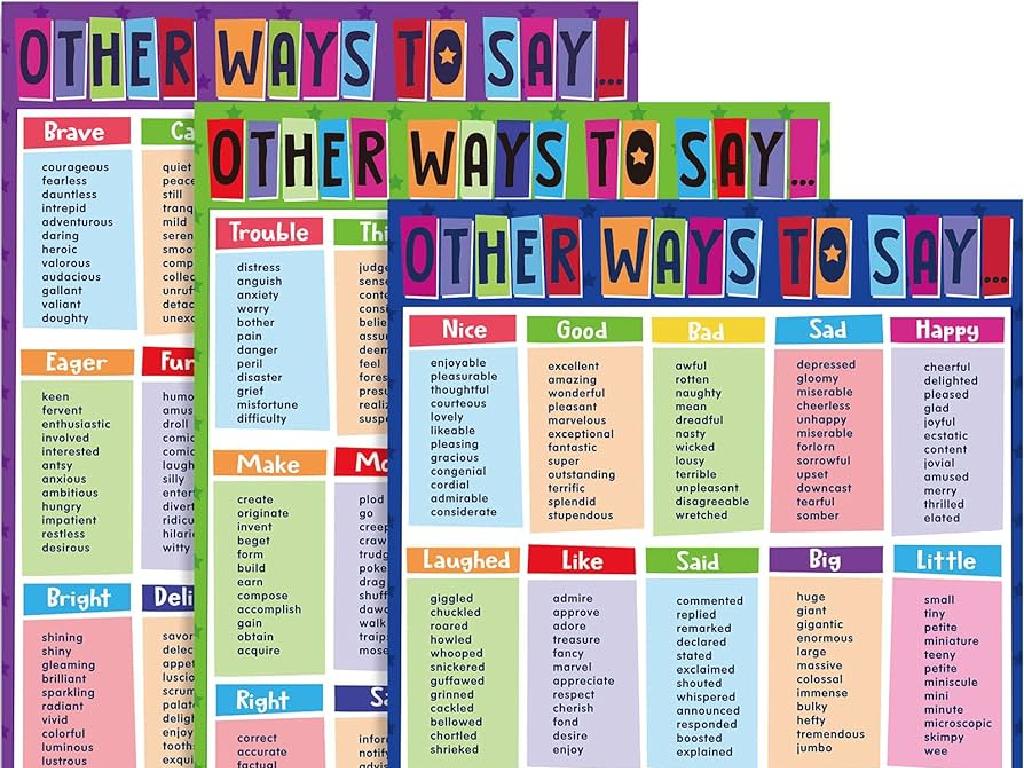Use Climate Data To Make Predictions
Subject: Science
Grade: Fourth grade
Topic: Weather And Climate
Please LOG IN to download the presentation. Access is available to registered users only.
View More Content
Welcome to Weather and Climate!
– Difference between weather and climate
– Weather is day-to-day, climate is long-term patterns
– Weather’s impact on daily life
– Weather decides our daily outfits and activities
– Climate’s role in the environment
– Climate influences ecosystems and agriculture
– Exploring climate data
– Climate data includes temperature, rainfall, and wind patterns over time
|
This slide introduces students to the fundamental concepts of weather and climate, emphasizing their differences and impacts. Weather is the day-to-day state of the atmosphere, affecting immediate decisions like clothing and outdoor activities. Climate, on the other hand, refers to the average weather conditions over a long period, influencing broader environmental aspects such as ecosystems and farming practices. Climate data helps us understand these patterns and make predictions about future conditions. Encourage students to think about how the weather affects what they do each day and how climate change might impact the world around them. Introduce the idea that scientists use climate data to predict weather patterns and discuss the importance of this data in planning for the future.
Understanding Weather
– What is weather?
– Weather is the day-to-day state of the atmosphere.
– Examples of weather types
– Sunny, rainy, snowy, and windy conditions.
– Weather’s changing nature
– Weather can change within hours or days.
– Weather vs. Climate
– Climate is the average weather over a long period.
|
This slide introduces the concept of weather to the students, explaining that it’s the condition of the atmosphere at any given time and place. Use everyday examples to illustrate different types of weather such as sunny, rainy, snowy, and windy. Highlight the fact that weather is not constant; it can change rapidly, which is why it’s important to check the forecast regularly. Contrast weather with climate by explaining that climate is the average of weather over many years. This sets the stage for discussing how climate data can help us make predictions about future weather patterns.
Understanding Climate
– Climate vs. Weather
– Weather is day-to-day, climate is over many years.
– Climate shapes our environment
– Climate affects the plants and animals in an area.
– Various climates around the world
– From deserts to rainforests, climates can be very different.
– Climate influences daily life
– What we wear, grow, and do depends on our climate.
|
This slide introduces the concept of climate and how it differs from weather. Emphasize that while weather can change in a matter of hours, climate is what we expect over a long period of time. Discuss how climate influences the natural ecosystem, including the types of plants and animals that can thrive in an area. Highlight the diversity of climates across the globe, from hot, dry deserts to wet, humid rainforests. Finally, relate the concept of climate to students’ everyday lives by discussing how it affects the clothes they wear, the food they eat, and the activities they can do. Encourage students to think about their local climate and how it shapes their daily routines.
Predicting Weather with Climate Data
– What is climate data?
– Records of temperature, rainfall, wind, etc.
– How scientists gather data
– Collected from various sources to study patterns
– Making predictions with data
– Use past data to forecast future weather events
– Importance of climate patterns
– Recognizing patterns helps predict weather changes
|
This slide introduces students to the concept of climate data and its role in predicting weather. Begin by explaining what climate data is and the types of information it includes, such as temperature and rainfall. Discuss how scientists collect this data from different places over time to understand the patterns in climate. Emphasize how this historical data is crucial for making informed predictions about future weather conditions. Highlight the importance of recognizing climate patterns to anticipate weather changes, which is essential for planning and preparedness. Engage the students by asking them to think of ways weather predictions can be helpful in their daily lives.
Reading Climate Graphs
– Understanding climate graph basics
– Climate graphs display weather trends over periods.
– Learning to read climate graphs
– We’ll explore the elements of these graphs.
– Interpreting weather patterns
– Patterns can indicate typical weather for a season.
– Predicting future weather
– Use past trends to guess future climate conditions.
|
This slide introduces students to the concept of climate graphs and their importance in understanding weather patterns. Begin by explaining what a climate graph is and the type of information it provides, such as temperature and precipitation over a year. Show students how to interpret the different parts of the graph, including the x-axis (time) and y-axis (weather data). Discuss how recognizing patterns in the data can help us predict future weather events or seasons. For example, if a graph shows increased rainfall in April for the past few years, we might predict a rainy April this year. Encourage students to think about how this information could be useful for planning activities or understanding the environment.
Making Predictions with Climate Data
– What are predictions?
– Educated guesses about the future, using data
– Why predict weather/climate?
– To prepare for what’s coming, like storms or heatwaves
– Benefits to people & communities
– Helps in planning activities, farming, and safety measures
– Discussing prediction examples
– Examples: Using a weather forecast to plan a picnic, or farmers checking forecasts to plant crops
|
This slide aims to explain the concept of making predictions based on climate data to fourth-grade students. Start by defining predictions as educated guesses about the future, made by analyzing data. Emphasize the importance of predicting weather and climate changes, such as preparing for extreme weather events and planning daily activities. Highlight how predictions can benefit individuals and communities by allowing for better planning and proactive measures to ensure safety and efficiency. Use relatable examples to illustrate these points, such as how a weather forecast can influence decisions like wearing a coat or scheduling outdoor events. Encourage students to think of times when they have used weather information to make decisions in their own lives.
Activity: Be a Weather Forecaster!
– Analyze provided climate data
– Predict next week’s weather
– Use data to guess sunny, rainy, or snowy days
– Create a forecast presentation
– Work with your group to make a slideshow
– Present to the class
– Explain your predictions to your classmates
|
This activity is designed to engage students with practical application of climate data to predict weather patterns. Provide students with a dataset of recent climate data, including temperature, precipitation, and wind patterns. Divide the class into small groups and instruct them to analyze the data to make informed predictions about the weather for the upcoming week. Each group will create a presentation, similar to a weather forecast, to share their predictions. Encourage creativity in their presentations, such as including visual aids or role-playing as weather forecasters. As a teacher, prepare to guide them on how to interpret data and offer insights into how meteorologists predict weather. This will help them understand the importance of climate data in real-world applications.






